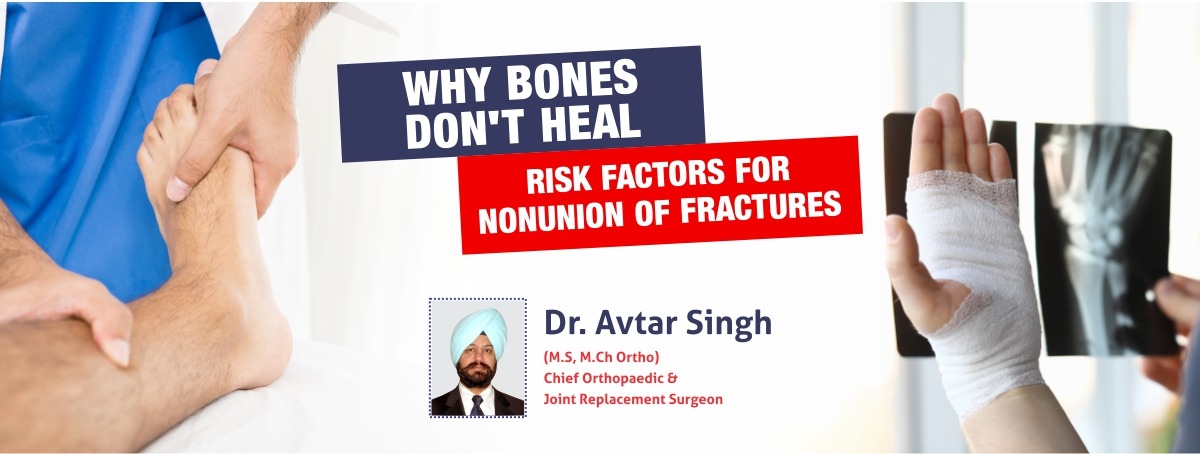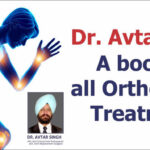
-
 Amandeep Hospital
Amandeep Hospital
- June 30, 2023
- Health Tips
Why Bones Don’t Heal: Risk Factors for Nonunion of Fractures
Even by getting the best surgical or nonsurgical treatment, sometimes broken bones do not heal. The bones need adequate stability, blood supply, and proper nutrition for healing, and in cases when requirements do not fulfill, it leads to the imperfect healing process.
There is one basic rule for the treatment of broken bones for which you should manage the right position without moving out of place until broken pieces of fracture heal. Depending upon fractures, you can maintain the stability of your surgical area by the cast, or sometimes it requires devices like plates, rods, screws, and frames. But if anyone does not pass on stability factors, this can interrupt the healing of bones.
Further, blood delivers the components like oxygen, healing cells, and the body’s chemicals required for healing to the fracture site. If blood supply is not suitable for the injured bone, then it can slow down the healing process.
Thirdly, broken bones need adequate nutrition to heal. If someone is having a deficiency of a well-balanced diet that includes vitamin C, vitamin D, protein, and calcium, then it can affect the healing process.
When bones fail to heal due to certain risk factors, it is called nonunion of fractures, and fracture that takes longer than usual to heal is known as “delayed union.”
Various Other Risk Factors For Nonunion Of Bones
Nonunion of a fracture can be a result of various factors such as malnutrition, osteoporosis, diabetes, and nicotine usage. Besides, risk can also be due to biomechanical instability, infection, vascularity, and reduced bone contact.
Malnutrition and vitamin deficiency
Protein malnutrition leads to the nonunion of bones by affecting callus composition to create a problem in the process of fracture healing. Similarly, deficiency of Vitamin B6 causes changes in bone to create an imbalance in the coupling between osteoblasts and osteoclasts, eventually delaying the process of healing.
Diabetes
According to a study by Perlman and Thordarson: 28 percent of diabetes patients shown nonunion state from 88 patients with ankle fusions. The implication of a possible cause of nonunion was sensory neuropathy.
Moreover, according to the report of Morgan et al. .5, patients having neuropathy before operation accounted for a 95% arthrodesis rate and failed to obtain fusion. The study of Frey et al.6 also blamed diabetes for the nonunion of ankle fusions. As such, we can conclude that diabetes is a risk factor for the nonunion of bones.
Osteoporosis
Osteoporosis disease reduces the density and quality of bone. Change in metabolism in osteoporosis causes a delay in callus maturation and fracture healing.
Cigarette smoking
Although studies do not reveal any clear association between smoking and bone mass, it is still evident that smoking contributes to osteoporosis and osteoporotic fractures. Patients who were Smokers are having a 5–10% bone density deficit than non-smoking patients.
Bone infections
Bone infection can result in puss and gap in bones to cause fracture of nonunion. Even devices implanted can loosen due to reduced bone quality by inflammation and difference in bones, eventually causing nonunion.
Inadequate vascularity
Vascular damage can render the failure of skeletal repair. The inadequate blood supply in open fractures due to loss of soft tissue causes damage to nutrient vessels. Diminished vascularity may prevent fracture union during the first three weeks after fracture.
Biomechanical instability
Fracture repair can influence due to the biomechanical instability at the site of fracture fixation. If fixation is less rigid, then it can increase the healing time of fractures. Alternatively, Initial mechanical stability to the bone fracture is necessary for early callus formation, increased vascularity, and tissue differentiation to result in faster fracture union.
Poor contact of bones
Undoubtedly, bone-to-bone contact is a vital requirement for healing fractures. Poor bone-to-bone connection leads to high strain and creates severe defects to be bridged by a fracture repair process.
Poor bone-to-bone contact at the fracture site can be due to factors like malalignment of fracture fragments, soft tissue interposition, the distraction of the fracture fragments, and bone loss. With the increase in defect size, there is a reduction in the chances of fracture union.
Factors during treatment
Some factors during treatment or orthopedic surgery can lead to nonunion of bones:
- Excessive stripping of the periosteum
- Damage to the soft tissue, blood supply during implant or fixation device insertion
- Damage to the bone
About Dr. Avtar Singh
- Dr. Avtar Singh is a chief orthopaedic and joint replacement surgeon practising at the Amandeep group of hospitals.
- Currently, heading the largest team of orthopaedic surgeons in the region, he has the experience of over 1.25 lac orthopaedic surgeries.
- He is the first doctor in North India to perform Robotic knee replacement surgery and is also the world’s first Punjabi surgeon to perform robotic knee surgery.
- Under his command, the largest team of orthopaedics in North India works that is substantial to provide appropriate treatment for nonunion of fractures.
- Having all the facilities of a trauma center, Dr. Avtar Singh also has amenities like an X-ray lab, ultrasound with a high-resolution, laboratory for investigation, and a CT scan.
- Our departments for Sports injuries, pediatric orthopaedics, foot and ankle injuries & rheumatoid Arthritis provide specific and comprehensive treatment to the patients and help them recover faster.
- We know that prevention is better than cure, so our proficient orthopaedic doctors are always available for counselling to help you with your bone fractures.
- By fusing the benefits of advanced technology with the clinical awareness of our leading specialists, we are serving the community for health services.
- If you are having any bone fracture, give us a call, we are the number one orthopaedic hospital that takes the onus to cure people suffering from nonunion of fractures.


